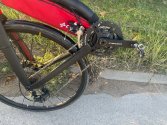I find it odd that you had lower top speed with the shorter cranks and claim the gearing is lower.
At the end of my summary I did say the what I communicated was anecdotal. That means, this is what I experienced at the time of the ride and my impressions. I did not say my results would or should be universal.
Given that, my top end speed is what I measured and I compared that against what I have measured in the past. 27.5 mph vs 29.5 mph.
My conclusion regarding the reason my top end speed was lower may be flawed, however I think it is sound. Reducing the length of a lever arm is going to reduce the torque. Torque is force times distance. For the same force I produce with my legs, the 170 mm arms are going to result in more torque than the 160 mm arms.
Power equals torque times angular velocity, or the torque times the cadence in revolutions per minute. What that means is that one can reduce the torque and produce the same power by increasing the cadence to compensate.
With the 170 mm cranks, I produced some power "P" at some cadence "C". With the 160 mm cranks I can produce the same power "P" as with the 170 mm cranks if I pedal at some cadence "C + x" where "x" is the additional rotational rate needed to compensate for the lower torque produced by the shorter cranks.
So all that said, my experience was that my top end was slower and I concluded that there was an "effective" reduction in gearing, "effective" being the operative word here.
I say this because if I was not able to produce the additional rotational rate "x" in my cadence to compensate for the lower torque, the effect would be the same as spinning a lower gear. I wasn't in a lower gear - in fact all the gear ratios have remained the same from my previous crankset - however, without compensating for the loss of torque with a properly high cadence, I'm not going to produce the same power. It's clear to me that at the upper end of my power output, I'm limited by how quickly I can spin. This may improve as I adjust to the shorter cranks. However, for that ride on that day at that time, my top end speed was 2 mph lower.
You say that the fitting shorter effectively makes the gear longer (higher), but actually if you spin at the same rate as your longer cranks, the reduction in the lever arm reduces the torque and you are producing less power (torque times cadence) If you produce less power you won't be going faster, you'll be going slower, and that's like being in a lower gear.
You can also look at this from the other side of the equation. You can keep the cadence the same and compensate for the reduction in torque due to the shorter lever arm by increasing the force applied. Then to get the same power as the longer crank arm you need to apply more force. This can feel just like being in a higher gear, requiring more muscle to get same power output. In reality, the gear ratio is the same, the cadence is the same but it feels harder because you're using more force.
Again, how much additional force you will need to apply to reach the same torque as your longer cranks depends on the power you need to produce, but the equation is the same. To produce some power "P" you can either hold the cadence steady and increase the force and therefore the torque or you can hold the torque steady and increase the cadence, or you can increase both.



